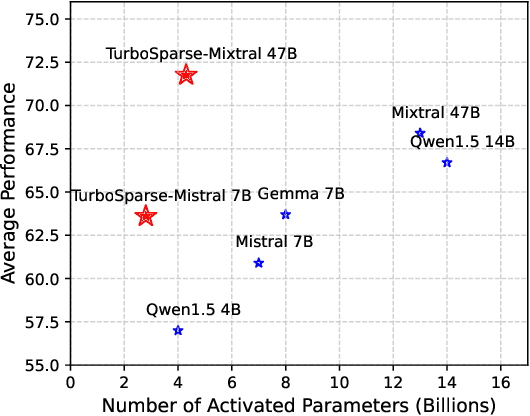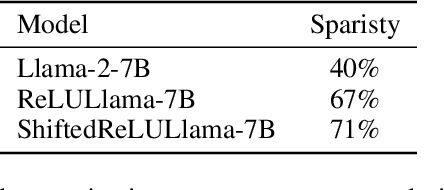Haotong Xie
Turbo Sparse: Achieving LLM SOTA Performance with Minimal Activated Parameters
Jun 11, 2024



Abstract:Exploiting activation sparsity is a promising approach to significantly accelerating the inference process of large language models (LLMs) without compromising performance. However, activation sparsity is determined by activation functions, and commonly used ones like SwiGLU and GeGLU exhibit limited sparsity. Simply replacing these functions with ReLU fails to achieve sufficient sparsity. Moreover, inadequate training data can further increase the risk of performance degradation. To address these challenges, we propose a novel dReLU function, which is designed to improve LLM activation sparsity, along with a high-quality training data mixture ratio to facilitate effective sparsification. Additionally, we leverage sparse activation patterns within the Feed-Forward Network (FFN) experts of Mixture-of-Experts (MoE) models to further boost efficiency. By applying our neuron sparsification method to the Mistral and Mixtral models, only 2.5 billion and 4.3 billion parameters are activated per inference iteration, respectively, while achieving even more powerful model performance. Evaluation results demonstrate that this sparsity achieves a 2-5x decoding speedup. Remarkably, on mobile phones, our TurboSparse-Mixtral-47B achieves an inference speed of 11 tokens per second. Our models are available at \url{https://huggingface.co/PowerInfer}
PowerInfer: Fast Large Language Model Serving with a Consumer-grade GPU
Dec 16, 2023



Abstract:This paper introduces PowerInfer, a high-speed Large Language Model (LLM) inference engine on a personal computer (PC) equipped with a single consumer-grade GPU. The key underlying the design of PowerInfer is exploiting the high locality inherent in LLM inference, characterized by a power-law distribution in neuron activation. This distribution indicates that a small subset of neurons, termed hot neurons, are consistently activated across inputs, while the majority, cold neurons, vary based on specific inputs. PowerInfer exploits such an insight to design a GPU-CPU hybrid inference engine: hot-activated neurons are preloaded onto the GPU for fast access, while cold-activated neurons are computed on the CPU, thus significantly reducing GPU memory demands and CPU-GPU data transfers. PowerInfer further integrates adaptive predictors and neuron-aware sparse operators, optimizing the efficiency of neuron activation and computational sparsity. Evaluation shows that PowerInfer attains an average token generation rate of 13.20 tokens/s, with a peak of 29.08 tokens/s, across various LLMs (including OPT-175B) on a single NVIDIA RTX 4090 GPU, only 18% lower than that achieved by a top-tier server-grade A100 GPU. This significantly outperforms llama.cpp by up to 11.69x while retaining model accuracy.
 Add to Chrome
Add to Chrome Add to Firefox
Add to Firefox Add to Edge
Add to Edge